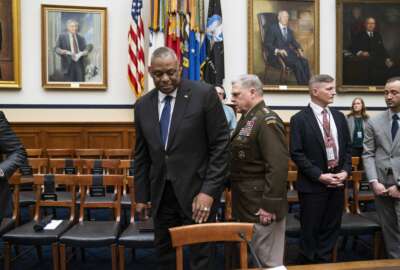What Congress wants Defense to look like in 2024 takes shape
House Armed Services committees at last voted out their bills for 2024 last week. The Senate Armed Services Committee released a statement of intent.
House Armed Services committees at last voted out their bills for 2024 last week. The Senate Armed Services Committee released a statement of intent. For one view of how things are shaping up, the Federal Drive with Tom Temin turned to the president and CEO of the Professional Services Council, David Berteau.
Interview Transcript:
Tom Temin I guess you could say it’s some progress that the committees, at least on the House side, voted out a bill, but that doesn’t really say much about the chances writ large.
David Berteau You’re right, Tom, And it’s great to have bills reported out of committee. On the House side, we actually get to read the bill and it will come to the floor after they returned from their 4th of July recess. So a couple of weeks from now, we’ll see that bill on the floor and there’ll be quite a few other amendments. The Senate bill is not yet released, and this is not uncommon. What we frequently have seen in recent years is the Senate Armed Services Committee will mark up its bill. They won’t release it. So we don’t actually know what’s in it and it may or may not come to the floor. In fact, the last couple of years, what we’ve seen is the negotiations between the House and Senate have gone directly from a House passed bill and a Senate marked up but not brought to the floor bill. And ultimately, we get what looks like a conference report without ever having gone through the actual full conference process. That may be what happens again this year. But let’s focus a little bit maybe on what we do know, which is the House bill to begin with.
Tom Temin Let’s start with the top line. But then that devolves quickly into questions about individual armed services and everything else.
David Berteau Right. And the top line appears to be the one thing on which there is firm and consistent agreement. The Fiscal Responsibility Act of 2023, that was the debt limit deal that the president signed just a month ago, agreed that the defense funding would be at the level the president requested. $886 billion divided up, mostly DoD a little bit the Energy Department and a few billion to other agencies. Both the House and Senate have stuck to that number. In the House’s case, they’ve said no supplementals for Ukraine or elsewhere. In the Senate’s case, their press release made it clear they do believe additional money is needed. So there’s agreement on the number, but not agreement on what the final number would be. The starting point number is there. Here’s the thing, though. That president’s budget request, did it address inflation or not? both committees have said it doesn’t cover inflation and yet it assumes 2.4% inflation, but it has a 3.3% increase. So from the numbers point of view, it covers inflation. By the way, the fiscal year starts in barely three months. Do you think we’re going to be at 2.4% inflation come October 1st?
Tom Temin Well, I guess it depends on what it is you’re buying. Some things are flat price, but some things they’re buying are going up.
David Berteau Some things they’re buying are going up. The biggest thing that’s going up, though, is embedded in that. And both House and Senate went along with this is a pay raise of not 2.4% to cover inflation, but 5.2% for both military and civilian personnel. And both the House and Senate have approved that. By the way, there’s no pay raise in there for contractors, even though, obviously they suffer from the same inflation pressures as the government employees did.
Tom Temin Right. So the squeeze has to pop out somewhere and therefore that would be in the procurement accounts, Right.
David Berteau So for DoD to absorb a 5.2% pay raise and that’s, comes out 35 to 40% of the entire DoD budget is going to pay and benefits for military and civilian personnel. So if you have if inflation is above that 2.4%, you’re adding in that 5.2% pay raise. I’m sorry to muck around with the numbers here, but and coupled with that means there’s too little money elsewhere, so something has to give. History says, by the way, what will yield here is contracts and the dollars that go to contractors. And ultimately what you get those dollars both in terms of services and in terms of goods.
Tom Temin There’s other inflationary elements outside of the pay raise itself, and that is health care costs continue to rise. And that’s a huge bite out of the total defense budget. So, yeah, it all mitigates in favor of contracts being the squeeze and contracts have costs depending on raw materials and inflationary effects that are still in the economy. And now you’re on the services side, which is not so much commodities and metals and energy, but yet people costs and the medical costs and so on that contractors incur.
David Berteau Two elements of that. One, of course, is the boundary between products and services is a lot fuzzier now than it was when you and I got into this business. There’s an awful lot of things that both the Defense Department and other agencies in the federal government are buying now as services that they used to buy as products. Legacy IT systems may have at one point you had to own the server farm yourself, but now the data is in the cloud, you don’t actually own the server or the cloud for that matter. All you pay for is access to it. Similarly with space launch, for instance, where, a lot of the satellites going up now are not owned by DoD. So that boundary is a lot fuzzier. But I think you touched on the workforce issue, and this is really where I think the impact and whether you call it from inflation or whether it’s just the fact that we still have 11 million vacant jobs and only 6 million people looking for work. Costs of workers have gone up over and over again. That’s not addressed in either, bill. In fact, it might be made a little bit harder in the two bills because of all the focus on the political aspects of diversity and equity and inclusion, which does have workforce impacts.
Tom Temin You bet. We’re speaking with David Berteau. He’s president and CEO of the Professional Services Council. And I want to switch gears for a minute here and ask you about a rule from DHS on controlled, unclassified information. This rule making goes back quite a while, doesn’t it? And now they seem to be reviving it.
David Berteau It does. Of course, controls unclassified information and maintaining security of that information is probably more important than ever. The situation is covered by the rule of increase in importance. The need for protection of such information is more important than when the proposed rule was issued, which is back, it was drafted at the end of the Obama administration. So it’s really quite a while back. But also the technology, the awareness, the available processes for both identifying threats and mitigating those threats have changed dramatically. And so we actually at PSC submitted comments on the proposed rule back in 2017. We were a bit surprised to learn earlier this month that the final rule would be being issued, and in fact it did come out on on the 21st of June last week. Our quick read of it reveals a number of problems. I’ll be happy to go into a couple of.
Tom Temin Yeah. What are they?
David Berteau First of all, there’s other ongoing work which will impact both the nature of the rule and the world in which it operates. Most importantly, that in fact, you’ve talked about it on this show and you’ve had that you’ve had guests in to explain. It is revision three of NIST standard 800-171, which is out for comment right now, will dramatically expand the coverage of 800-171, get it closer in what contractors need to do to what federal agencies need to do on their own systems, which is a different NIST standard. And comments are due on that on July 14.
Tom Temin I was going to say those are not quite due yet.
David Berteau No, as we’re right around the corner from that. So, what was the hurry to get this rule after a six and a half year wait to get this rule out when we know the universe in which it operates is about to change? The second thing is the rule punts a lot of issues to a FAR rule, the timing and content of which are unknown to us at this time. We haven’t seen that proposed FAR rule, so it’s really hard to tell. So and then finally, the rule as we track back against our comments made again six years ago, the rule failed to accommodate most of the industry comments both from PSC and from other trade groups that submitted comments along the way there, without a good explanation in many cases as to why that was done. We’ve reached out to the DHS and asked for a discussion on this. They may well have good reasons for having done what they did when they did it, but I think that that that dynamic still remains to be played out.
Tom Temin Interesting. Yeah, we’ll have to keep an eye on that one. Maybe they will delay it because of the NIST change, because we had an interview from Ron Ross himself on on the changes to 171. They’re not finalized yet, as you point out, because comments aren’t even due until July. And then it takes NIST a while to inculcate the comments, and they do listen to comments, into the final version of that revision of 171.
David Berteau They do. And I think if you go back to your interview with Ron and you heard him talk a lot about the changing nature of the threat and the changing capabilities that the government has to respond to those threats and that will require, I think, a dynamic situation to keep on going. But there’s one other aspect to it, Tom, that I think is beyond the DHS and even beyond the NIST standards, and that is the the inadequate recognition by the government of of controlled unclassified information in an operational environment as well as in a protecting tech data for for new systems, etc. When you’re operating around the world, whether you’re the Defense Department or the Agency for International Development or any other federal agency that has operations in other countries, you’re operating for your support work on the global commercial network. Right. And you’re you’re buying food, fuel supplies, telecommunications, access to computers, etc., from companies and systems that will never be compliant with U.S. standards because they are in different countries and they have different standards of their own. Some of those guys are not necessarily friendly to us. As soon as you start putting into that commercial system what you’re buying, when it’s going to be delivered, where it’s going to be delivered, to whom it’s going to be delivered, what the quantity is, you are starting to run the risk of creating something that looks to me like potentially controlled, unclassified information. It will give you operational data that you need to have in order to perhaps do some nefarious things to us. But none of that is taken into account in these systems. And it’s one of the problems that at PSC we’ve had trouble getting the government to recognize that that’s a big issue and it’s not one that you can solve by changing U.S. regulations.
Tom Temin And switching gears one more time. GSA’s Oasis Plus solicitation finally came out. Does this take into account that ruling on task order pricing that came from one of the federal district courts that kind of upended the whole thing, the whole strategy for task order at the time of task order pricing as opposed to pricing at the time of getting on to the contract.
David Berteau Right. Oasis Plus was released last week of the solicitation. I want to give kudos to GSA, Tom, because they interacted with industry multiple times over many weeks or even months in order to sort of get draft solicitations, get input on those draft solutions, get them written, get them refined and and ultimately issued. So the process by which GSA developed this solicitation is is an example of the government operating at its best to get what it needs. It has to because we could be buying from this from this contract for ten years, which is kind of what GSA estimate. But then it got up, ended a little bit back in April when the court of federal claims issued their ruling. It was on a different solicitation was on Polaris, a different contract. But it upended the basis of of particularly unprice bids for task order contracts. So the pricing would come in when the task orders came out rather than at the front end of the contract where it would be at best notional. GSA did make some changes to accommodate that Polaris ruling. They think they’ll still be able to move forward with that. And of particular note, and I think this is a real bellwether for for the government, a lot of future on ramps. You’ve seen this in a lot of the GSA contracts where if you’re not on at the beginning, you’re not on and the only way you can get on is to team with or by somebody who’s on the contract. So by keeping it open and having it regularly open to those on ramps, that could be a real plus going forward. GSA briefed us on this at last week’s PSC acquisition conference. Tiffany Hixon, who I think has been a guest on both your show and others, explain this in some detail. And we’re really looking forward to seeing what comes out of the solicitation process here.
Copyright © 2025 Federal News Network. All rights reserved. This website is not intended for users located within the European Economic Area.
Tom Temin is host of the Federal Drive and has been providing insight on federal technology and management issues for more than 30 years.
Follow @tteminWFED







